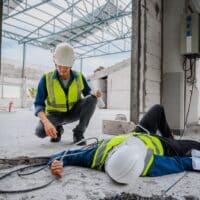Most Common Causes of Construction Accidents

Construction sites are inherently dangerous places, and construction work consistently ranks as one of the most dangerous jobs in Pennsylvania. That said, there is no question that many if not most construction accidents could be prevented if owners, developers and contractors took reasonable steps to provide a safe worksite, including making sure construction workers have the safety gear and equipment they need to do their jobs safely. Below, we explore some of the most common causes of construction accidents and the reasons behind them. If you or a loved one has been hurt in a Philadelphia construction accident, contact Benedum Law for help from a skilled and experienced Chestnut Hill personal injury lawyer.
-
Falls from Heights: Falls are the leading cause of fatalities in the construction industry. Workers often operate on scaffolding, ladders, and roofs, where a lack of proper fall protection systems or a momentary lapse in attention can lead to severe injuries or death.
-
Struck by Objects: Construction sites are bustling with activity, and workers are at constant risk of being struck by falling tools, debris, or machinery. Hard hats and other protective gear are essential, but they may not always be sufficient to prevent injuries.
-
Electrocutions: Exposed wires, unfinished electrical systems, and the use of power tools in close proximity to water sources create a significant risk of electrocution. Proper training and adherence to electrical safety standards are crucial to avoid such accidents.
-
Caught-In/Between Hazards: Workers can become trapped or crushed by heavy machinery, collapsing structures, or materials being moved on the site. Ensuring machinery is properly maintained and that protocols are followed during demolition or excavation can help mitigate these risks.
-
Slips, Trips, and Falls: Uneven surfaces, wet or slippery floors, and cluttered work areas can lead to falls that may not be fatal but can still result in serious injuries. Keeping the site clean and organized is a simple yet effective way to prevent such accidents.
-
Overexertion and Repetitive Stress Injuries: The physical demands of construction work can lead to overexertion, resulting in injuries such as sprains, strains, and chronic musculoskeletal disorders. Regular breaks and proper lifting techniques can help reduce these types of injuries.
-
Vehicle Accidents: With trucks, forklifts, and other vehicles frequently moving around construction sites, the risk of collisions or accidents involving pedestrians is high. Implementing traffic control measures and ensuring that drivers are trained and vigilant can help prevent such incidents.
-
Fires and Explosions: Flammable materials, gas lines, and the use of welding equipment can create fire or explosion hazards. Strict adherence to fire safety protocols and proper storage of flammable materials are essential to prevent these types of accidents.
-
Exposure to Hazardous Materials: Construction workers may be exposed to a variety of hazardous materials, including asbestos, lead, and chemical solvents. Proper training, use of protective equipment, and adherence to safety regulations are necessary to protect workers from these hazards.
-
Lack of Training and Safety Protocol Violations: Inadequate training and non-compliance with safety regulations are underlying factors in many construction accidents. Ensuring that workers are properly trained and that safety protocols are strictly followed is critical to preventing accidents.
Contact Benedum Law for Help After a Construction Accident in Philadelphia
At Benedum Law, we understand the devastating impact construction accidents can have on workers and their families. If you or a loved one has been injured in a construction accident in Philadelphia, our experienced personal injury attorney is here to help you navigate the legal process and fight for the compensation you deserve. Call us today at 215-529-7848 for a free consultation over the phone or at our convenient and comforting Chestnut Hill law office.